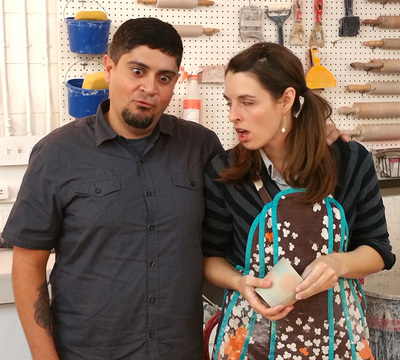Nigel, a native Floridian with a proud Peruvian-American heritage, works full-time as a public archaeologist and studio potter. He has degrees in cultural anthropology (University of West Florida, 1998) and ceramics (University of Florida, 2002), and has held resident artist positions at Arrowmont and the St. Petersburg Clay Company (now the Morean Center for Clay). Nigel's work is also exhibited nationally in juried and invitational exhibitions. What got you interested in clay? Nigel: The medium itself—the pliability of it and being able to manipulate it. After that, it was the history of the use of clay. Did you ever try to make historic replicas? Nigel: I tried and didn’t like it. There are people who are really good at that, and I’ll leave it to them to do that. How do you fire your work? Nigel: Cone 6 oxidation mainly. Recently, I have been able to soda fire again in a friend's kiln. What is the main clay body you work with? Nigel: Standard 266 What are your dreams for your future with clay? Nigel: The opportunity to make more pots, have more time in the studio, and make more art, clay or otherwise. I like working with wood, a contrasting media. I think the future of craft is blending media. What is your biggest challenge as an artist? Nigel: Finding the time to grow as an artist. I could say a lot of other stuff about space etc., but what it really all boils down to is time. Cheyenne briefly studied theater before completing her undergraduate degree in ceramics (Murray State University). She also has a master’s degree in ceramics from the University of Florida. Her current work is influenced by her early experiences with theater, and she uses performance and film to include a narrative context for the particular functions of her work. What attracted you to clay? Cheyenne: When I first saw someone making something with clay I thought, “Oh, you can make things.” Growing up, I did theater and music, but it never occurred to me I could make things. I like the theatricality, the openness of clay. My desires for clay now are different than they were initially. What are your dreams for your future with clay? Cheyenne: I don’t know if I have a future with clay. I also like photography, sewing and film, etc. I have so many interests and want to pursue them. I feel like the clay world is really attached to the materiality of the medium. I am not. I have been working in clay for ten years, and it has kept me interested this long. I don’t know; maybe I will continue using clay. I am really interested in performance, and I would like to move my work into the world of fine art. I am applying for grants all the time, but so far I have only gotten grants from craft and ceramics organizations. What is the main clay body you work with? Cheyenne: Little Loafers How do you fire your work? Cheyenne: Cone 6 oxidation mainly. What is your biggest challenge as an artist? Cheyenne: FOLLOW THROUGH, maybe indecision. Cheyenne has done a series of satirical infomercials using her functional ceramics. Check out the Center-Peas infomercial.
Molly Hatch Engobe Recipe (Cindy Kolodjeski Vitreous Engobe): Cone 04, but can be fired to Cone 6 as well
Use a 50/50 Macaloid/CMC mix slaked in hot water and blended as medium for brushing. Add stains to above base proportionally 1:1. (Cheyenne mentioned she uses less stain successfully as well.)
1 Comment
|







